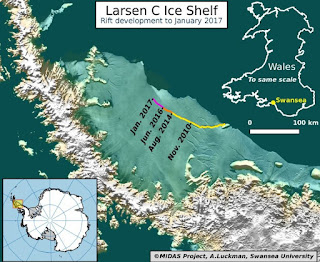Happy New Year!
It's 2017 and time to get back to business. I've had a lot of stuff on and so the Blog and YouTube channel have been neglected unfortunately. However - you can expect content more frequently from now on!
I'm kicking off 2017 with a post on a HUGE natural event that is taking place right now. That is the break away of one of the largest icebergs ever recorded in Antarctica.
 |
| Picture by Adrian Luckman at the MIDAS Project, http://www.projectmidas.org |
It is now expected that the massive iceberg will breakaway within the next few months.
Why is this happening?
- It is important to note that this is a natural occurance. It is a normal geographical event for icebergs to breakaway from a shelf, but the immense size of the ice is what is unusual here.
- The rift has been present for decades, and has been splitting gradually as mentioned. The sudden rise in the speed in which the rift is increasing, however, is widely believed to have been accelerated due to climate warming, but there is no direct evidence to support this.
Why is this significant?
- The break-off may effect the stability of the entire shelf, leading to the whole shelf collapsing. This was previously seen in another, similar rift event on the Larsen B ice shelf.
- Estimates predict that if all the ice held back by the Larsen C shelf entered the sea, global waters would rise by 10cm.
- The landscape of Antarctica will be altered drastically by the loss of the shelf, should it become unstable and break up as a result of the rift.
- The collapse of a major ice shelf such as Larsen C could accelerate the melting of glacial ice which is linked to warming oceans.
 | |||
| The Larsen C rift seen from above. The rift is about 100m wide and estimated to be half a kilometre deep. Picture by the NASA Earth Observatory. (http://earthobservatory.nasa.gov) |